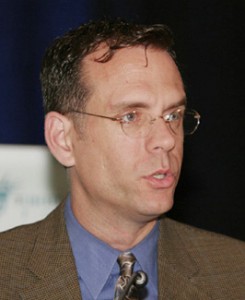OutRight: The Pope, the Gays, and World Peace
Inconsistency plagues Benedict’s holy messages.
 By Dale Carpenter
By Dale Carpenter
The 2008 visit of Pope Benedict XVI to the United States is cause to reflect on what his papacy has meant so far for gay people. There is some good, but much bad and ugly, to report.
The largest and most pressing public-relations problem confronting the Catholic Church in the United States today is the fallout from the priest sex scandal. Some conservative Catholics have tried to blame “homosexuals” for the sexual abuse of children by priests, since most of it involved male priests and boys under their supervision. Some suggested that the Church purge all gays from the priesthood.
But an antihomosexual purge presents both practical and theological problems for the Vatican. As a practical matter, homosexuals are probably disproportionately drawn to the priesthood. It offers young homosexual Catholics some palliative for the guilt and shame they may feel for being homosexual. It also shields them from embarrassing questions about why they aren’t married.
Theologically, the Church distinguishes between innate homosexual orientation, which is not a sin, and homosexual acts, which are. For Catholicism the orientation itself is blameless, so expelling someone from the priesthood for that alone is hard to justify.
Under Benedict, the Vatican’s response has been a mixed bag. On the one hand, current homosexual priests have not been purged, though like all priests they must remain celibate.
On the other hand, in late 2005 the Vatican declared that those who “show profoundly deep-rooted homosexual tendencies” are not suitable candidates for the priesthood. If, however, these “homosexual tendencies” are “simply the expression of a transitory problem,” then the person can be ordained if the tendencies are “overcome at least three years before ordination.”
That’s a bit convoluted, and the details will be worked out over time, but it suggests that mere homosexual orientation unaccompanied by any homosexual acts now justifies forbidding a man to enter the priesthood. In practice, of course, this will not prevent all homosexuals from becoming priests. But it will bar those who understand and openly acknowledge their homosexual orientation.
If the Vatican under Benedict has blurred the distinction between homosexual acts and orientation, the Pope himself has at least maintained another distinction of importance to gay people.
During his U.S. visit, Benedict spoke of the priest scandal in a way that differentiated between homosexuals and pedophiles. “I would not speak in this moment about homosexuality but pedophilia, which is another thing,” he said. “We would absolutely exclude pedophiles from the sacred ministry.”
This statement accomplished two important things. First, it reaffirmed that while pedophiles would be expelled from the priesthood, homosexual priests would not be. Second, it repudiated the association of homosexuality with pedophilia, an old and harmful defamation against gay people that has been used to justify much discrimination.
It is significant that a man of Benedict’s standing would separate the two, while so many who admire him do not. Despite his religious objection to homosexual acts, Benedict has not ignored all we have learned from the study of homosexuality. He recognizes that homosexual orientation and pedophilia are distinct phenomena. He deserves credit for his willingness to say so publicly.
Which is what makes his implied, but extravagant, criticism of gay marriage so disappointing. According to the Institute for Marriage and Public Policy, a conservative think tank opposed to gay marriage, Benedict has spoken publicly about marriage 111 times. In these speeches, he has connected the traditional definition of marriage to preventing violence, maintaining legal order, and even preserving world peace.
In his January 1, 2008, World Day of Peace message, Benedict said: “Everything that serves to weaken the family based on the marriage of a man and a woman . . . constitutes an objective obstacle on the path to peace.”
Elsewhere he has bemoaned the “growing crisis of the family, which is based on the indissoluble bond of marriage between a man and a woman.” When this “truth about man is subverted or the foundation of the family is undermined, peace itself is threatened and the rule of law is compromised, leading inevitably to forms of injustice and violence.”
The implication is that gay marriage, along with many other modern developments, will contribute to human catastrophe. Throughout history, gay people have been blamed for everything from the fall of the Roman Empire, to the Black Plague, to every hurricane, tornado, and earthquake that has ever struck civilization. Now we must add global destabilization to the list?
Benedict is correct that weakening families undermines social stability, with many potential harmful consequences. But to accept Benedict’s conclusion, we would have to believe that gay marriage will somehow hurt heterosexual families. Like many others, he seems to bundle gay marriage with a miasma of genuinely harmful trends like illegitimacy and rampant divorce.
The problem is that there is no good reason to indulge that fear. There is no evidence yet that gay marriage has undermined traditional families or contributed to violence, lawlessness, and war in countries like Canada, the Netherlands, and Spain. It is no more plausible to think gay marriage will produce cataclysms than to believe (as expressed by the late Jerry Falwell) that accepting “the gays and the lesbians” contributed to 9/11.
Benedict’s concerns are not strictly theological ones. They are empirical, testable by evidence and experience, and thus subject to reasonable criticism outside his faith tradition. Day by day, year by year, they become harder to take seriously.
Writing from the conservative side, Dale Carpenter began his column for OutSmart in 1994, when he lived in Houston. Now residing in Minneapolis, Carpenter is a University of Minnesota Law School professor.











Comments